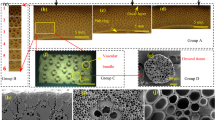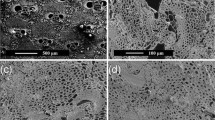Abstract
Bamboo is a fiber-reinforced bio-composite since its culm wall is mainly composed of parenchymatous ground tissue in which vascular bundles are embedded. In order to analyze the mechanical properties of bamboo as a function of its components, tensile tests were performed on bamboo blocks and the corresponding volume fractions of fiber and parenchymatous ground tissue were measured. More significant linear relationships were found between tensile properties and volume fractions of the bamboo components. The tensile strength and modulus of elasticity of bamboo fiber and parenchymatous tissue were estimated according to the linear equations obtained by regression analysis. The macrographs of fractured bamboo blocks and the micrographs of fracture surfaces obtained by scanning electron microscope were also analyzed. Further tensile tests on separated bamboo fiber bundles were analyzed. Results show that the tensile strength of bamboo fiber obtained from the tests on bamboo blocks was higher than that on separated fiber bundles. This might be due to the interaction between components in bamboo in which parenchymatous ground tissue can pass loads and distribute the stresses loaded on fibers.











Similar content being viewed by others
References
Ahmad M, Kamke FA (2005) Analysis of calculate bamboo for structural composite materials: physical and mechanical properties. Wood Sci Technol 39(6):448–459
Chuma S, Hirohashi M, Ohgama T, Kasahara Y (1990) Composite structure and tensile properties of mousou bamboo (in Japanese). Zairyou 39:847–851
Deshpande AP, Rao MB, Rao CL (2000) Extraction of bamboo fibers and their use as reinforcement in polymeric composites. J Appl Polym Sci 76:83–92
Gordon JE (1984) The new science of strong materials or why you don’t fall through the floor. Princeton University Press, USA, p 287 (ISBN 0-691-02380)
Inokuchi Y, Fushitani M, Chuma S, Ozawa M, Kubo T, Sato K (1997) Effects of volume fraction of bundle sheath on the vibrational properties of bamboo (in Japanese). Mokuzai Gakkaishi 43(5):391–398
Inokuchi Y, Fushitani M, Kubo T, Sato K (1999) Effects of water extractives on the moisture-content dependence of vibrational properties of bamboo (in Japanese). Mokuzai Gakkaishi 45(2):77–84
Inokuchi Y, Fushitani M, Kubo T, Sato K (2002) Effects of volume fraction of bundle sheath and water extractives on bending creep behavior of bamboo under changing moisture conditions (in Japanese). Mokuzai Gakkaishi 48(6):413–424
Jiang ZH, Sun ZJ, Ren HQ (2006) Application of advanced bio-composites in wind blades (in Chinese). Acta Mater Compos Sin 23(3):127–129
Liese W (1998) The anatomy of bamboo culms. International Network for Bamboo and Rattans (INBAR), Beijing, Tech rep no. 18
Obataya E, Kitin P, Yamauchi H (2007) Bending characteristics of bamboo (Phyllostachys pubescens) with respect to its fiber–foam composite structure. Wood Sci Technol 41:385–400
Qiao SR (1997) Micromechanical properties of composites. Northwestern Polytechnical University Press, China, p 187 (ISBN 978-7-5612-0913-4)
Shao Z-P, Fang C-H, Tian G-L (2009) Mode I interlaminar fracture property of moso bamboo (Phyllostachys pubescens). Wood Sci Technol 45(5–6):527–536
Sui S, Li R (2003) A study of structure and performance of bamboo fibers (in Chinese). J Text Res 24(6):535–537
Sun ZJ, Chen Q, Jiang ZH (2008) Processing and properties of engineering bamboo products (in Chinese). Acta Mater Compos Sin 25(1):80–83
Zhang QS (2003) Attaching importance to science and innovation in the processing and utilization of bamboo timber in China (in Chinese). J Zhejiang For Coll 20(1):1–4
Author information
Authors and Affiliations
Corresponding author
Rights and permissions
About this article
Cite this article
Shao, ZP., Fang, CH., Huang, SX. et al. Tensile properties of Moso bamboo (Phyllostachys pubescens) and its components with respect to its fiber-reinforced composite structure. Wood Sci Technol 44, 655–666 (2010). https://doi.org/10.1007/s00226-009-0290-1
Received:
Published:
Issue Date:
DOI: https://doi.org/10.1007/s00226-009-0290-1




